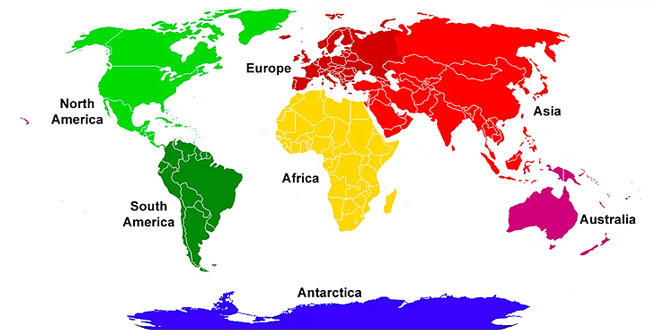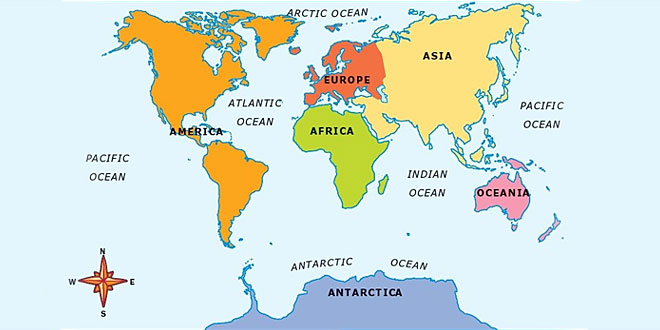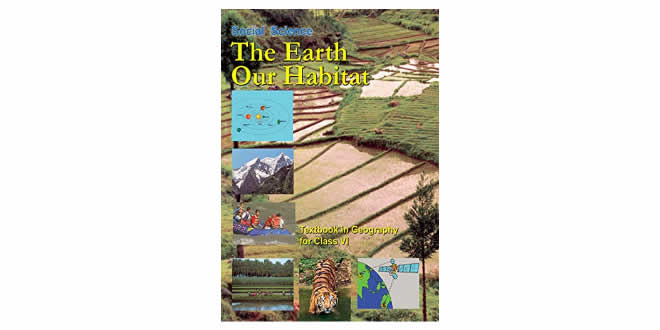Major Domains of the Earth – 6th Class NCERT CBSE Social Science (Geography) Chapter 05
Question: Answer the following questions briefly.
- What are the four major domains of the Earth?
- Name the major continents of the Earth.
- Name the two continents that lie entirely in the Southern Hemisphere.
- Name the different layers of atmosphere.
- Why is the Earth called the ‘blue planet’?
- Why is the Northern Hemisphere called the Land Hemisphere?
- Why is the biosphere important for living organisms?
Answer:
- The four major domains of the Earth are: lithosphere, hydrosphere, atmosphere and biosphere.
- The seven major continents of the Earth are: Asia, Europe, Africa, North America, South America, Australia and Antarctica.
- The two continents that lie entirely in the Southern Hemisphere are: Australia and Antarctica.
- The different layers of atmosphere are: troposphere, stratosphere, mesosphere, thermosphere and exosphere.
- The Earth is called the ‘blue planet’ because more than 71 per cent of its surface is covered with water.
- The Northern Hemisphere is called the Land Hemisphere because the greater part of Earth’s landmass lies in the Northern Hemisphere.
- The biosphere is the narrow zone of contact between land, water and air. It is in this zone that life, that is unique to Earth, exists. All the living organisms are linked to each other and to the biosphere for survival.
Major Domains of the Earth – Question: Tick the correct answers.
- The mountain range that separates Europe from Asia is
(i) the Andes (ii) the Himalayas (iii) the Urals - The continent of North America is linked to South America by
(i) an Isthmus (ii) a Strait (iii) a Canal - The major constituent of atmosphere by per cent is
(i) Nitrogen (ii) Oxygen (iii) Carbon dioxide - The domain of the Earth consisting of solid rocks is
(i) the Atmosphere (ii) the Hydrosphere (iii) the Lithosphere - Which is the largest continent?
(i) Africa (ii) Asia (iii) Australia
Answer:
- The mountain range that separates Europe from Asia is
(i) the Andes (ii) the Himalayas (iii) the Urals √ - The continent of North America is linked to South America by
(i) an Isthmus √ (ii) a Strait (iii) a Canal - The major constituent of atmosphere by per cent is
(i) Nitrogen √ (ii) Oxygen (iii) Carbon dioxide - The domain of the Earth consisting of solid rocks is
(i) the Atmosphere (ii) the Hydrosphere (iii) the Lithosphere √ - Which is the largest continent?
(i) Africa (ii) Asia √ (iii) Australia
Major Domains of the Earth – Question: Fill in the blanks.
- The deepest point on the Earth is _________ in the Pacific Ocean.
- The _________ Ocean is named after a country.
- The _________ is a narrow contact of land, water and air that supports life.
- The continents of Europe and Asia together are known as __________.
- The highest mountain peak on the Earth is __________.
Answer:
- The deepest point on the Earth is Marina Trench in the Pacific Ocean.
- The Indian Ocean is named after a country.
- The biosphere is a narrow contact of land, water and air that supports life.
- The continents of Europe and Asia together are known as Eurasia.
- The highest mountain peak on the Earth is Mount Everest.
Question: Name the continents in increasing order of their size.
Answer: Generally identified by convention rather than any strict criteria, up to seven regions are commonly regarded as continents. Ordered from largest in size to smallest, they are: Asia, Africa, North America, South America, Antarctica, Europe, and Australia.
Question: Name the oceans in increasing order of their size.
Answer: On Earth, an ocean is one of the major conventional divisions of the World Ocean. These are, in descending order by area, the Pacific, Atlantic, Indian, Southern (Antarctic), and Arctic Oceans.
Question: What is the composition of the atmosphere?
Answer:
- The atmosphere is made up of layers of colorless, odorless and tasteless gases.
- Air is a mixture of gases, water vapour, dust particles and smoke.
Question: Name the different layers of the atmosphere.
Answer: Atmosphere layers are:
- Troposphere
- Stratosphere
- Mesosphere
- Thermosphere
- Exosphere.
Question: What are the main elements of biosphere?
Answer:
- Oxygen, nitrogen, hydrogen, and carbon are the most abundant elements in Earth’s biosphere.
- This element is the most abundant in the biosphere and people and animals must inhale it to survive.
Question: Which is larger – Europe or Australia?
Answer: Europe is larger than Australia.
Major Domains of the Earth – Question: How is nitrogen a significant gas?
Answer: Nitrogen helps in the growth of living organisms.
Question: What is the Junction of carbon dioxide?
Answer: Carbon dioxide absorbs the heat radiated by the earth and thus keeps the planet warm.
Question: What is the height of the Mt. Everest?
Answer: The height of the Mt. Everest is 8,848 metres.
Question: In which Hemisphere does Asia lie?
Answer: Asia lies in the Eastern Hemisphere.
Question: Name the world’s largest hot desert. Where is it located?
Answer: The Sahara desert. It is located in Africa.
Question: How is North America linked to South America?
Answer: North America is linked to South America by a narrow strip of land called the Isthmus of Panama.
Question: Name the Oceans that surround the continent – North America.
Answer: The Pacific Ocean, the Atlantic Ocean and the Arctic Ocean.
Question: Which two oceans surround South America on the east and the west?
Answer: On the east – the Atlantic Ocean On the west – the Pacific Ocean.
Major Domains of the Earth – Question: Name the research stations of India in Antarctica.
Answer: Maitri and Dakshin Gangotri.
Question: What percent of the earth is covered with water?
Answer: More than 71 per cent of the earth is covered with water.
Question: What percent of earth is covered with land?
Answer: 29 per cent of earth is covered with land.
Question: How much of the earth’s water is found in the oceans?
Answer: More than 97 percent of the earth’s water is found in the ocean.
Question: Why is the ocean water not fit for human use?
Answer: It is because the ocean water is very salty.
Question: Why do the mountaineers carry with them oxygen cylinders?
Answer: The mountaineers carry with them oxygen cylinders so that they can easily breathe at high altitudes.
Question: What is the nature of the temperature?
Answer: The temperature decreases as we go upwards.
Question: Name the continents that surround the pacific ocean.
Answer: Asia, Australia, North America and South America.
Question: Which is the busiest ocean from the point of view of commerce?
Answer: The Atlantic ocean is the busiest ocean from the point of view of commerce.
Question: Mention two reasons of fast removal of soil from stops.
Answer:
- Cutting of forests for wood.
- Clearing land for agriculture.
Question: What happened to Andaman and Nicobar islands during Tsunami?
Answer: Parts of these islands were submerged under water during Tsunami.
Question: What makes the water of lakes and rivers unsuitable for human use?
Answer: Discharge of waste material into lakes and rivers makes the water unsuitable for human use.
Major Domains of the Earth – Question: Mention any two reasons of air pollution.
Answer:
- Emission from industries
- Emission from vehicles
Question: Mention the three main components of the environment.
Answer: The three main components of the environment are the lithosphere, the atmosphere and the hydrosphere. The lithosphere is the solid portion of the earth. The gaseous layers that surround the earth is the atmosphere. The atmosphere is made up of oxygen, nitrogen, carbondioxide and other gases. The hydrosphere refers to the big area of water that covers the earth’s surface. This water is in the forms of ice, water and water vapour.
Question: Write a short note on the ‘hydrosphere’.
Answer: The hydrosphere refers to the water bodies that are found on the earth’s surface. More than 71% of the earth is covered with water. This water is found in all its forms – ice, water and water vapour. Running water in oceans and rivers and in lakes, ice in glaciers, underground water and the water vapour in atmosphere. More than 97% of the earth’s water is found in oceans. The ocean water is very salty, hence not of human utility. A large proportion of the rest of water is in the form of the ice sheets and glaciers or under the ground. A very small percentage (0.03%) is available as fresh water. It is this water that we use.
Question: Explain biosphere – the domain of life.
Answer: The biosphere is a narrow zone of the earth where land, water and air interact with each other to support life. It is in this zone that life exists. There are several species of organisms that vary in size from microbes and bacteria to large mammals. All living organisms including humans are linked to each other and to the biosphere for survival.
Question: Give an account of the composition of atmosphere. Also discuss the importance of the components.
Answer: The atmosphere is composed mainly of nitrogen, and oxygen. Together they make up about 99% of clean, dry air. Nitrogen 78% and oxygen 21%. Apart from these two major gases, there are other gases too in the atmosphere. These gases include carbon dioxide, argon and others comprise 1% by volume. ‘Oxygen is the breath of life’ while nitrogen helps in the growth of living organisms. Carbon dioxide absorbs heat radiated by the earth. In this way, it keeps the planet warm. It is also essential for the growth of plants.
Question:What is atmosphere? Write about its different layers.
Answer: The atmosphere is a thin blanket of air that surrounds the earth. It provides us with the air we breathe and protects us from the harmful effects of sun’s rays. The atmosphere extends upto a height of about 1,600 km. The atmosphere is divided into five layers based on composition, temperature and other properties. These layers are – the troposphere, the stratosphere, the mesosphere, the themosphere and the exosphere.
Question: Give the details of all the major continents.
Answer: There are seven major continents – Asia, Europe, Africa, North America, South America, Australia and Antarctica.
- Asia: is the largest continent. It covers about one third of the total land area of the earth. It lies in the Eastern Hemisphere. The Tropic of Cancer passes through this continent. Asia is separated from Europe by the Ural mountains on the west. The combined land mass of Europe and Asia is called the Eurasia (Europe + Asia).
- Europe: This continent lies to the west of Asia. The Arctic circle passes through it. It is bound by water bodies on three sides.
- Africa: It is the second largest continent after Asia. The Equator or 0° latitude runs almost through the middle of the continent. A large part of Africa lies in the Northern Hemisphere. It is the only continent through which the Tropic of Cancer, the Equator and the Tropic of Capricorn pass. It is bound on all sides by oceans and seas. The world’s largest hot desert, i.e. the Sahara Desert lies in this continent. The world’s longest river the Nile flows through it.
- North America: It is the third largest continent of the world. It is linked to South America by a very narrow strip of land called the Isthmus of Panama. This continent lies completely in the Northern and Western Hemisphere.
- South America: It lies mostly in the Southern Hemisphere. The Andes, world’s longest mountain range, runs through its length from north to south. The world’s largest river, the Amazon flows through this continent.
- Australia: It is the smallest continent. It lies entirely in the Southern Hemisphere.
- Antarctica: It lies completely in the Southern Hemisphere. It is a large continent. The South Pole lies almost at the center of this continent It is permanently covered with thick ice sheets because it is located in the South Polar region. Permanent human settlement is not found here.
The major continents:

Question:Write about the major oceans of the world.
Answer: There are four major oceans in the world—the Pacific Ocean the Atlantic Ocean, the Indian Ocean and the Arctic Ocean.
- The Pacific Ocean: It is the largest ocean and is spread over one-third of the earth. Mariana Trench, the deepest part of the earth, lies under the Pacific Ocean. This ocean is circular in shape. Asia, Australia, North and South Americas surround it.
- The Atlantic Ocean: It is the second largest ocean in the world. It is ‘S’ shaped. It is flanked by the North and South Americas on the Western side and Europe and Africa on the eastern side. The coastline of this ocean is highly indented. It is the ideal location for natural harbors and ports. Commercially, it is the busiest ocean.
- The Indian Ocean: It is the only ocean named after country, that is, India. The shape of the ocean is triangular. It is bound by Asia in the north, by Africa in the west and by Australia in the east.
- The Arctic Ocean: It is located within the Arctic Circle and surrounds the North Pole. It is connected with the Pacific Ocean by a narrow stretch of shallow water known as Berring Strait. See the map given in the previous question

 Class Notes NCERT Solutions for CBSE Students
Class Notes NCERT Solutions for CBSE Students



